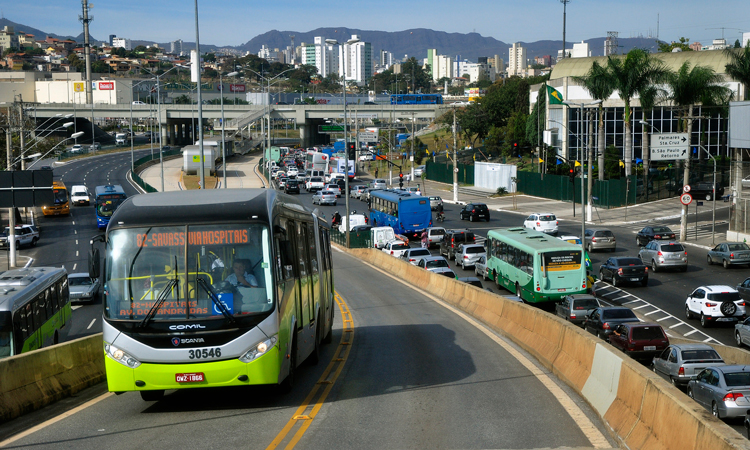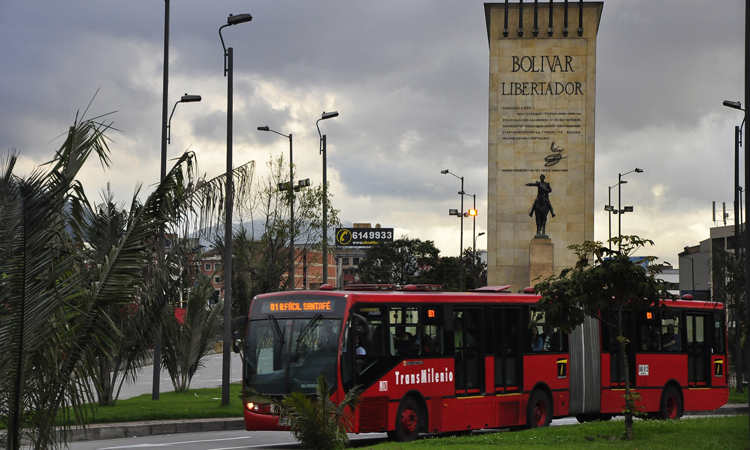Bus Rapid Transit (BRT): a key tool for urban sustainability
- Like
- Digg
- Del
- Tumblr
- VKontakte
- Buffer
- Love This
- Odnoklassniki
- Meneame
- Blogger
- Amazon
- Yahoo Mail
- Gmail
- AOL
- Newsvine
- HackerNews
- Evernote
- MySpace
- Mail.ru
- Viadeo
- Line
- Comments
- Yummly
- SMS
- Viber
- Telegram
- Subscribe
- Skype
- Facebook Messenger
- Kakao
- LiveJournal
- Yammer
- Edgar
- Fintel
- Mix
- Instapaper
- Copy Link
Posted: 19 June 2016 | Juan Carlos Muñoz - Bus Rapid Transit Centre of Excellence, Laurel Paget-Seekins - Massachusetts Bay Transportation Authority | No comments yet
There is a general sense that Bus Rapid Transit (BRT) is a key tool for urban sustainability, but in order for it to achieve that potential it has to be more than just a public transport mode. As Juan Carlos Muñoz from the Bus Rapid Transit Centre of Excellence1 and Laurel Paget-Seekins from the Massachusetts Bay Transportation Authority explain, we have to think beyond mode share or the peak passengers per direction per hour. BRT has to be part of a restructuring of transportation and urban space.


Credit: World Resources Institute
The Bus Rapid Transit Centre of Excellence has carried out five years of research addressing the opportunities and challenges of meeting the potential of BRT. The research is documented in our book Restructuring Public Transport through Bus Rapid Transit and centres around three themes: institutional relationships, BRT in the city, and operations and design.
BRT is being used as a tool in the formalisation of informal transit and this requires significant changes to institutions and the development of new capacity for the public sector. It transforms the relationships between private operators, government authorities and civil society. In addition to new challenges, these changing relationships create opportunities, such as an increased role for public participation and the setting for a debate about the proper level of subsidy and fares.
Any changes to the public transport network take place within a complex urban context. From the city to the individual passenger, level change is hard. Even for just a single corridor, political power and perceptions of BRT shape the choice of mode and conflicts over public space for mobility. In both developing and developed cities it is a challenge to coordinate land use planning around public transport corridors. For passengers new service means having to learn new routes, which requires the design and implementation of passenger information systems.
Finally, there are challenges to creating a rapid high capacity surface transit system, regardless of the type of city it is located in. New technology is bringing opportunities; automated data collection can improve service efficiency, planning and real-time information to users. Well planned network design can increase capacity and reduce transfers. The switch to a formal system can improve working conditions and the efficiency of scheduling vehicles and driver shifts. An analysis of performance on BRT corridors can determine the factors that increase boarding, speed, reliability and safety.
Even though BRT is fairly well established around the world, there are many remaining issues that have to be considered moving forward. BRT must not surrender its need for rapidness. Rapidness allows it to provide not just a fast trip, but also a low wait, as well as a high capacity transport mode. Speed is not just good for users; it also increases operators’ productivity, therefore reducing its cost. To provide rapidness, a segregated busway is often needed. Also, high demand stations must be equipped with off-board payment facilities; stations must not be too close to each other; and overpassing lanes must be provided.
The special infrastructure needed for efficient BRT triggers two concerns: safety and urban impact. When BRT is adequately designed it usually reduces accidents in comparison to having buses operating in mixed traffic. An ordered flow of buses and cars should be easier to understand for pedestrians. It is important to avoid the temptation to make pedestrians take flyovers to reach stations. Instead, buses and vehicles are the ones that must stop to allow pedestrians to cross at ground level.
Regarding its urban impact, BRT may seem too large an intervention for cities. However, recently implemented BRT corridors add a second overpassing lane only where needed (for example next to stations). Still, when we think of the space taken by BRT infrastructure we should consider how the space would be otherwise utilised. The space needed for mobility responds to the mobility needs of the rush hour. And the space taken from the city for rush hour mobility needs stays fixed for the rest of the day. So it is very important to have efficient solutions during peak periods. Cities must make public transport and non-motorised transport as attractive as possible. The alternative, based on cars, takes significantly more space and not just along the corridor but in local streets and parking too.


Caption: The BRT network in Bogotá, Colombia. Credit: World Resources Institute
It seems that when a strong BRT network is built, citizens see public transport disputing the car’s hegemonic role. Let’s take Santiago and Bogotá for example, which are quite comparable in terms of size and socioeconomic indicators. Both have structured massive public transport networks of approximately 100km. However, Santiago has a metro network and Bogotá has BRT. Both present very similar figures in terms of average speed (in Santiago it is higher on the newest lines) and demand (moving approximately 2.5 million users per day and 45,000 pax/hr-direction on their busiest link). However, while Santiago is losing its battle to foster public transport utilisation (its modal share fell from 83.4% in 1977, 70.5% in 1991, 51.9% in 2001 and to 46.9% in 2012), Bogotá is winning it, since public transport modal share has stayed almost constant at approximately 65% since 1998. Thus, claiming urban space for public transit seems to have a negative impact compared to investing in underground transit and leaving the surface for the car.
So this takes us to the metro vs BRT question: is BRT a substitute for metro? Sometimes yes, but most of the time, no.
These are modes that can complement each other very well. While metro can provide fast long-distance travel due to very limited stops to serve high demand volumes, BRT can exploit the flexibility of buses that can shift between corridors providing non-stop multi-corridor trips. Buses can also overpass providing express services. Buses can enter and exit local neighbourhoods and freeways, etc. We need to be more innovative when thinking about buses. Multimodal fare integration (which we see as a growing trend worldwide) provides more opportunities for network design that we would have if passengers were expected to reach their destinations through a direct service.
When comparing BRT with metro, one of the aspects in which BRT falls short is reliability. To earn the respect of public transport users and of citizens in general, BRT must overcome important hurdles: it must not only be fast, but reliable. To achieve reliability, BRT must address headway regularity; the more regular the headways are, the lower the average waiting time, and the average comfort of the trips. Also, the travelling experience improves because waiting time and comfort become more reliable. Thus, we need BRT to add an extra R; BRRT: Bus Rapid and Reliable Transit. Also, during off-peak periods BRT must incorporate schedules so users can plan their trips while transfers are adequately coordinated.
Another key aspect that needs to be addressed to improve the quality of service is comfort. The developing world must stop designing service based on 6 pas/m2. This figure is the average across many buses and many areas inside the bus. It is also the best recipe for long-term failure.
The world is starting to observe automation: in cars and driverless metros. It is possible we could see driverless BRT very soon too – at least while the buses operate in separate corridors. It will help to keep regular headways, stick to schedules, dock smoothly at stations, implement eco-driving and reduce accidents. It seems that the industry is already realising the opportunity here.
BRT is often built according to a trunk and feeder network. This may be effective for reducing costs, but force passengers to transfer. And we all hate transferring. So we need to reduce them by implementing open BRT corridors and run multi-corridor services. We also need to make transfers less traumatic. We can turn this experience into culture, commerce, fun!
Finally, funding and affordability are crucial. We will not attract car drivers to shift towards public transport through low fares, but through high quality service instead. To provide this service, subsidies are needed. The developing world must realise that these subsidies are needed not just for equitable reasons, but because it is efficient to do so. In the developing world we should try to allocate some of the funding to low income people that would otherwise consider high quality public transport systems unaffordable.
There are lots of challenges: speed, reliability, driverless buses, comfort, few and better transfers, adhering to the ‘urban’ context, and low emissions. Our book doesn’t solve all of the challenges, but it provides research that we hope will prove useful to academics and practitioners to get started. More importantly, it shows how international and interdisciplinary research can fit together to increase the potential of BRT to address what we all know to be urgent urban problems.
References
Biography




Related topics
Fleet Management & Maintenance
Issue
Issue 3 2016
Related modes
Bus & Coach
Related cities
United States of America
Related organisations
Bus Rapid Transit Centre of Excellence, Massachusetts Bay Transportation Authority
Related people
Juan Carlos Muñoz, Laurel Paget-Seekins








